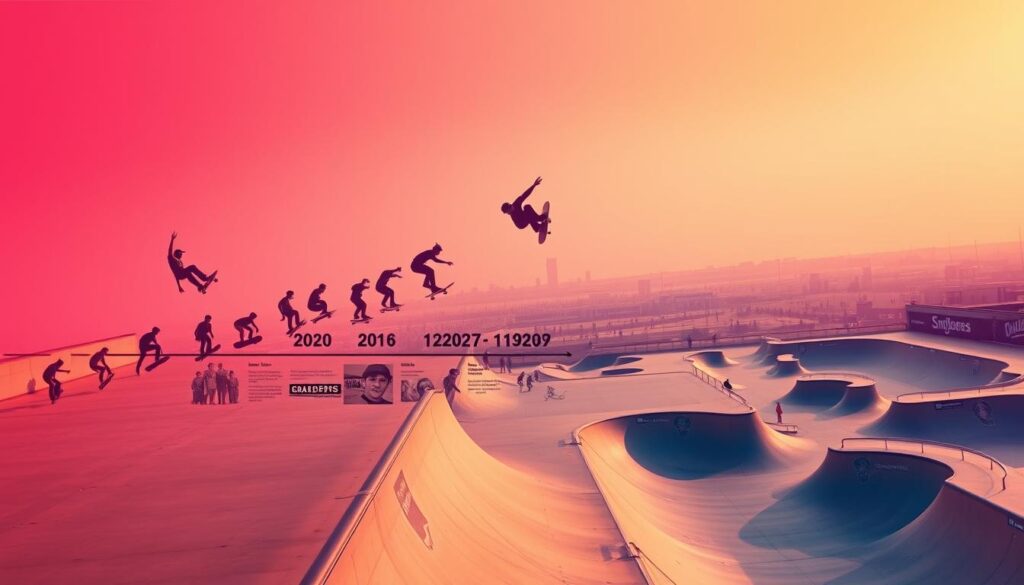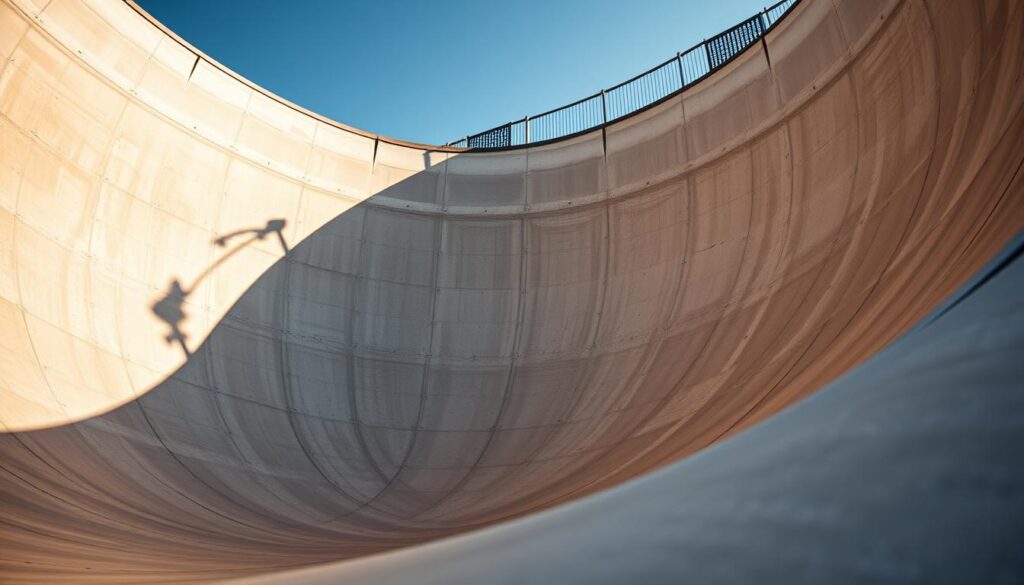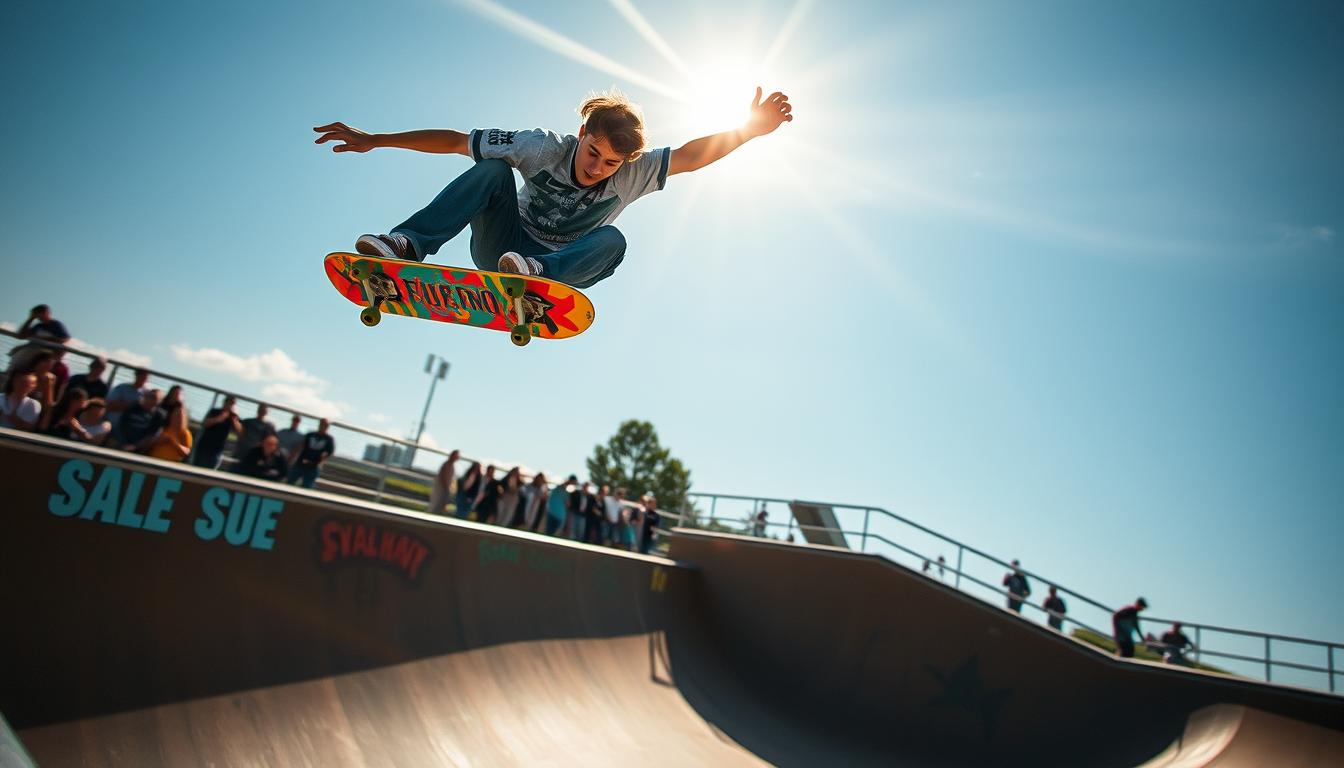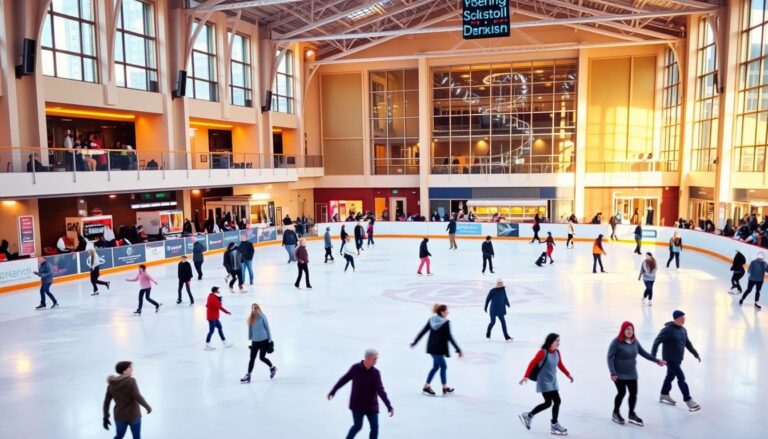The Thrills of Vert Skating: A Comprehensive Guide
Imagine standing at the top of a huge vertical ramp, your skateboard on the edge. You feel the rush of adrenaline. This is vert skating – an exciting extreme sport that turns skateboarding into a thrilling art.
What is vert skating? It’s a high-energy sport where skaters do amazing aerial tricks on vertical surfaces. They test their limits and push skateboarding to new heights.
Vert skating is more than just riding a skateboard. It’s a mix of skill, creativity, and bravery. Skaters jump up walls, doing tricks that seem impossible. It’s the top of skateboarding skill and creativity.
This guide will dive into the world of vertical skateboarding. You’ll learn about its history, key techniques, and the gear you need. You’ll also see the culture that makes vert skating a way of life.
Whether you’re new to vert skating or want to improve, this guide is for you. We’ll cover everything from basic stances to advanced tricks. You’ll learn all about vert skating.
Professional skaters have made vert skating a global extreme sport. The journey of vert skating is as exciting as the tricks. It shows human creativity, determination, and the drive to push limits.
Get ready to be inspired, challenged, and motivated. Your vert skating adventure starts here, now. Are you ready to experience the ultimate skateboarding thrill?
What Is Vert Skating: Understanding the Basics
Vert skateboarding is an exciting sport that challenges gravity and human limits. It turns skateboarding into a vertical art form. Riders must push beyond what’s expected.
Vert skating is a unique skateboarding style. It focuses on tricks on vertical surfaces, like halfpipes or ramps. Unlike street skateboarding, it requires precise control and fearlessness.
Key Elements of Vertical Skateboarding
Knowing the basics of vert skating is key. It helps riders improve and understand the sport’s complexity:
- Vertical Surfaces: Ramps angled at 90 degrees or near-vertical
- Momentum Management: Generating speed through precise pumping techniques
- Aerial Control: Executing rotations and complex tricks while airborne
- Balance and Precision: Maintaining control during high-intensity maneuvers
Different Types of Vert Skating Styles
Vert skateboarding has many exciting variations that test riders’ skills:
- Traditional Vert: Classic halfpipe skateboarding with big air tricks
- Mega Ramp: Extremely large ramps requiring advanced techniques
- Park Skating: Combining vert techniques with skatepark obstacles
Essential Terminology for Vert Skaters
Aspiring vert skaters need to learn key terms. Understanding drop-ins and aerial rotations is essential. The language of vert skating shows its technical and creative side.
The Evolution of Vert Skating Through the Decades

Vert skating started in the 1970s as a bold new movement. It moved from street skating to a vertical sport. Skaters found empty swimming pools in California’s drought, creating the first vertical spots.
The early days of vert skating were full of creativity and DIY spirit. Pioneers like Tony Alva and Stacy Peralta from the Z-Boys changed skate culture. They brought radical tricks that expanded what was possible on a board.
- 1970s: Birth of vertical skateboarding in empty pools
- 1980s: Emergence of professional vert skating competitions
- 1990s: Mainstream recognition and media exposure
- 2000s: Technological advancements in skateboard design
- 2010s: Global expansion and Olympic recognition
By the 1980s, vert skating became a recognized sport. Vert ramps in skateparks let skaters work on aerial tricks. Competitions started, giving skaters a stage to show their skills.
The 1990s saw vert skating’s popularity soar. TV events and sponsorships made top skaters icons. New skateboard designs and safety gear also helped the sport grow.
Today, vert skating keeps evolving. It’s recognized worldwide, with a community that values its history and innovation.
Essential Equipment for Vert Skating Success
Vert skateboarding needs special gear for performance, safety, and durability. The right equipment makes a big difference in your skating. It’s key for both new and experienced riders.
Choosing the Right Vert Skateboard
Choosing the right skateboard is the first step in vert skateboarding. Consider these important factors:
- Deck width (usually 8.25″ to 9″ for vert)
- Deck material (maple wood is best for durability)
- Truck stability and how well they respond
Protective Gear Requirements
Safety is very important in vert skateboarding. You need:
| Protective Item | Purpose | Recommended Type |
|---|---|---|
| Helmet | Protects your head | Multi-impact skateboard helmet |
| Knee Pads | Protects your joints | Hard shell, articulated design |
| Elbow Pads | Protects your arms | Flexible impact-absorbing material |
| Wrist Guards | Prevents fractures | Rigid splint with comfortable padding |
Maintenance and Equipment Care
Keeping your gear in good shape is important. Regular checks and care are key for safety and performance. Here’s what to do:
- Look for cracks in the skateboard deck
- Lubricate truck bearings
- Replace worn-out grip tape
- Store your gear in a cool, dry place
Quality gear protects you and makes skating better. Skaters say buy from brands that focus on skateboarding.
Anatomy of a Vert Ramp: Design and Structure

Vert skate ramps turn flat areas into thrilling spots for skaters. Knowing how these ramps are made can boost your skills and love for the sport.
The key parts of a vert skate ramp are:
- Flat Bottom: The base that gives you speed
- Transition Zones: Curved parts that link flat and vertical areas
- Vertical Wall: The steep part where tricks are done
- Coping: A metal rail at the top for grinding and catching
Building a ramp needs careful planning. Most pro ramps are 8 to 12 feet tall. The curves between surfaces are designed for smooth transitions.
The choice of materials is also important. Plywood is often used because it’s durable and smooth. Skaters look for ramps with:
- Smooth, splinter-free surfaces
- Even curves
- Strong support
- Weather-resistant finishes
Understanding vert skate ramp design helps both new and experienced skaters. Every detail, from curves to materials, shapes the skating experience.
Fundamental Vert Skating Techniques for Beginners
Learning to vert skate means mastering basic skills that boost confidence and ability. This thrilling sport needs precision, balance, and bravery. Whether you’re new or moving from street skating, knowing key techniques changes your skating journey.
Skaters get better by practicing and progressing slowly. The first step in learning vert skating is grasping basic movements and body control.
Basic Stance and Position
Your stance is the base for all vert skating moves. Important parts include:
- Feet shoulder-width apart
- Knees slightly bent for stability
- Weight centered over skateboard
- Arms relaxed but ready for balance
Drop-in Techniques
Drop-in is a key skill that marks the difference between beginners and more advanced skaters. To do a drop-in well:
- Position back foot on tail of skateboard
- Front foot near front truck bolts
- Keep body weight forward
- Commit with confidence
Essential Pumping Methods
Pumping keeps vert skaters moving without pushing. Good pumping needs precise weight shifts and rhythmic body actions. To improve on the ramp, focus on these:
- Use leg compression and extension
- Shift body weight smoothly
- Maintain consistent rhythm
- Keep upper body stable
Getting good at vert skating takes time, patience, and regular practice. Every small step adds to your confidence and skill.
Advanced Vert Skating Tricks and Maneuvers
Mastering vert skating tricks takes a lot of work, skill, and courage. Skaters who are good at it make their rides look amazing.
These tricks need exact technique and getting ready mentally. Skaters must control their body and know where they are to do these moves right.
- 360-degree rotations
- Inverted aerial spins
- Grab variations
- Complex lip tricks
Experts say to start with simple tricks and then move to harder ones. This way, you build up your skills slowly.
| Trick Difficulty Level | Skill Requirements | Practice Time |
|---|---|---|
| Beginner | Basic ramp control | 1-3 months |
| Intermediate | Air awareness | 3-6 months |
| Advanced | Complex rotation skills | 6-12 months |
Remember, safety is key when trying hard vert skating tricks. Always wear safety gear and practice with a pro watching.
Thinking about the trick before you do it is very important. Skaters need to be confident and keep practicing to get better.
Safety Protocols and Best Practices in Vert Skating
Vert skating is all about skill and safety. It’s important to protect yourself while learning. Knowing the risks and how to avoid them makes skating safer and more fun.
Common Injuries and Prevention
Vert skaters face special challenges that need careful protection. Common injuries include:
- Wrist sprains from unexpected falls
- Knee and ankle strains during complex maneuvers
- Head impacts from improper landing techniques
Stopping these injuries starts with the right gear and training. Wearing the right safety gear is not just a good idea—it’s a must.
Emergency Response Guidelines
| Injury Type | Immediate Action | Follow-up Care |
|---|---|---|
| Minor Bruises | Rest and Ice | Monitor for swelling |
| Sprains | RICE Protocol | Professional medical evaluation |
| Head Impact | Stop Skating Immediately | Neurological assessment |
Training and Conditioning Tips
Getting good at vert skating means being physically ready. Work on:
- Core strength development
- Flexibility training
- Balance and coordination exercises
- Cardiovascular endurance
By following these safety tips, you’ll skate better and safer. Remember, safe skating is smart skating.
Famous Vert Skaters Who Shaped the Sport

Vert skating history is filled with amazing athletes. They turned skateboarding into a global extreme sport. These pioneers pushed limits, defied gravity, and inspired many with their skills and new tricks.
Iconic athletes reshaped vert skating, becoming famous names. Tony Hawk is a top name, known for his 900-degree spin. He made a huge impact, not just in skateboarding.
- Tony Hawk: Considered the godfather of modern vert skating
- Danny Way: Known for massive mega ramp performances
- Bob Burnquist: Brazilian skater who transformed aerial tricks
- Christian Hosoi: 1980s vert skating legend with distinctive high-flying style
These athletes did more than just tricks. They built a culture around vert skating. Their innovations and wins opened doors for others, making skateboarding mainstream.
Today’s vert skating stars keep pushing limits, exploring new aerial tricks. Each new generation builds on the giants before them, expanding vert skating’s possibilities.
The influence of these legendary skaters goes beyond winning. They’ve inspired millions, created new tricks, and made vert skating a real sport. It’s a mix of athleticism, creativity, and excitement.
Major Vert Skating Competitions and Events
Vert skating competitions are the top shows of skill, creativity, and flying tricks. They gather the world’s best vert skaters. This turns skateboarding into a thrilling sport for fans.
Vert skating has many places for athletes to show their amazing skills. Skaters work hard to win big tournaments. These tests their technical skills and creativity.
X Games Vert Championships
The X Games are the biggest deal for vert skating. Skaters do huge tricks on halfpipes. Judges look at:
- Difficulty of tricks
- Height and amplitude
- Technical execution
- Style and creativity
Professional Tournament Circuit
There are many international vert skating events. These tournaments are key for skaters to show their skills. They help skaters get known in the vert skating world.
Regional Competition Guidelines
Regional competitions are great for new vert skaters. They have easier rules and support for up-and-coming athletes. This helps them grow their skills.
Skaters in competitions must show:
- Technical skill
- Safety awareness
- Consistent performance
- Innovative tricks
Whether watching or competing, vert skating competitions are thrilling. They give a peek into the amazing world of aerial skateboarding.
Training Progression: From Beginner to Advanced

Learning to vert skate is an exciting journey. It turns beginners into skilled athletes. To move from beginner to advanced, you need dedication, practice, and a good training plan.
At the start, it’s important to understand the basic stages of skill development. The training path includes several key phases:
- Foundation Stage: Mastering basic balance and board control
- Intermediate Level: Developing confidence on vertical surfaces
- Advanced Progression: Executing complex tricks and techniques
Successful vert skaters focus on building skills consistently. Your early training should focus on:
- Perfecting stance and body positioning
- Learning drop-in techniques
- Understanding momentum and weight distribution
- Building core strength and flexibility
Mental preparation is also key. Visualization and gradual challenges help skaters overcome fears and build confidence.
Cross-training is vital for skill development. Add strength training, yoga, and balance exercises to improve your vert ramp skills.
The Physics Behind Vert Skating Movements
Vert skateboarding is more than just skill—it’s a dance with physics. Every move a skater makes involves force, momentum, and balance. These elements turn simple motion into stunning aerial art.
Skaters use science to create amazing performances. Knowing these mechanics can greatly improve your vert skateboarding skills.
Understanding Momentum and Balance
Momentum is key in vert skateboarding. Skaters build speed with body movements that turn energy into motion. Important momentum principles include:
- Pumping techniques that generate vertical speed
- Body positioning to maximize energy transfer
- Utilizing gravitational forces during ramp transitions
Your center of gravity is vital for balance in vert skateboarding. The right weight distribution is needed for successful tricks.
Air Dynamics in Vert Skating
Air dynamics are important when a vert skater flies through the air. The way a skater positions their body affects lift, rotation, and trick success.
- Reducing air resistance through streamlined postures
- Controlling spin rates using angular momentum
- Managing body rotation during aerial transitions
Pro tip: Small adjustments in body angle can create dramatic changes in air dynamics during vert skateboarding.
Finding and Choosing Vert Skating Venues
Finding the right vert skate ramp can make your skating experience amazing. The best place for you depends on more than just a smooth surface.
When looking for vert skating spots, think about these important things:
- Ramp quality and maintenance
- Safety features and protective barriers
- Local skater community support
- Accessibility and location proximity
Public skateparks are great for finding vert ramps. They offer different levels of difficulty. Urban centers and suburban areas often have well-kept parks.
Skaters say to check these things when picking a spot:
- Surface smoothness
- Ramp angle and height
- Surrounding environment
- Local regulations
Some skaters like private spots for better training. These places have special features and are less crowded.
If you’re watching your budget, try community centers or skate clubs. They often have good ramps at lower prices. Talking to experienced skaters can help you find great spots nearby.
Always put safety first when choosing a place to skate. Make sure the equipment is good, wear the right gear, and know the rules of each spot.
Building a Supportive Vert Skating Community
Vert skateboarding is more than just tricks. It’s about making connections with other skaters. Your journey is about building relationships that make your skating better.
To create a supportive community, you need to be active and enthusiastic. Skaters can use many ways to connect and grow:
- Local skate park meetups
- Online forums dedicated to vert skateboarding
- Social media skating groups
- Regional skateboarding events
Being part of the community means more than just showing up. Respect for others, a willingness to learn, and sharing knowledge are key in vert skateboarding.
Mentorship is important for skill development and building relationships. Experienced skaters can help newcomers. Beginners bring new ideas and energy to the community.
Here are some ways to strengthen vert skating connections:
- Attend local skateboarding workshops
- Participate in friendly competitions
- Share tutorial videos and tips online
- Organize community skate sessions
Your involvement can change the local vert skateboarding scene. Every interaction is a chance to inspire, learn, and grow together.
Conclusion
Vert skating is more than a sport; it’s a thrilling way to grow and express yourself. It combines skill, creativity, and adrenaline. Riders face new challenges and explore the limits of gravity.
We’ve looked into vert skating’s techniques, safety, and community. It’s a discipline that requires skill and passion. Every trick tells a story of precision and dedication.
Remember, getting better at vert skating takes practice, safety, and a commitment to grow. Whether you’re new or experienced, the vert skating world values your effort and passion.
Now, it’s time to get ready, stay focused, and enjoy the ride. Set big goals, meet other skaters, and keep learning. Your unique style and contribution are eagerly awaited in the world of vert skating.






